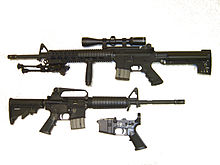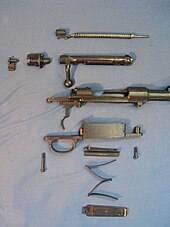Receiver (firearms)
In firearms terminology, the firearm frame or receiver is the part of a firearm which integrates other components by providing housing for internal action components such as the hammer, bolt or breechblock, firing pin and extractor, and has threaded interfaces for externally attaching ("receiving") components such as the barrel, stock, trigger mechanism and iron/optical sights.[1] The receiver is often made of forged, machined, or stamped steel or aluminium; in addition to these traditional materials, modern science and engineering have introduced polymers and sintered metal powders to receiver construction.[2]
Mounting[edit]
A barrel can be fixed to the receiver using barrel and receiver action threads or similar methods.
In US law[edit]

For the purposes of United States law, the receiver or frame is legally the firearm,[3] and as such it is the controlled part. The definition of which assembly is the legal receiver varies from firearm to firearm, under US law. Generally, the law requires licensed manufacturers and importers to mark the designated receiver with a serial number, the manufacturer or importer, the model and caliber. In addition, makers of receivers are restricted by International Traffic in Arms Regulations. Thus, in the case of a firearm that has multiple receiver parts (such as the AR-15, which has an upper and a lower receiver), the legally controlled part is the one that is serialized. For the AR-15 rifle, the lower receiver assembly is legally considered the actual receiver[4] (although it is functionally a chassis that also houses the separate trigger group); while in the FN-FAL rifle, it is the upper assembly that is serialized and legally considered the receiver.[5][6]
Unfinished receivers[edit]
"Unfinished receivers", also called "80 percent receivers" or "blanks", are partially completed receivers with no serial numbers. Purchasers must perform their own finishing work in order to make the receiver usable. The finishing of receivers for sale or distribution by unlicensed persons is against US law.[7] Because an unfinished 80% receiver is not a firearm, purchasers do not need to pass a background check.[7] The resulting firearm is sometimes called a "ghost gun".[8] An AR-15 variant made from an 80% receiver was used in the 2013 Santa Monica shooting.[7]
3D printed receivers[edit]
Two 3D printed polymer lower receivers for the AR-15 have been released: the AR Lower V5 and the Charon.
References[edit]
- ^ "27 CFR 478.11: Meaning of terms". US Government. 2016. Retrieved 16 September 2016.
Firearm frame or receiver. That part of a firearm which provides housing for the hammer, bolt or breechblock, and firing mechanism, and which is usually threaded at its forward portion to receive the barrel.
- ^ "HK416 modular assault rifle / carbine / upper receiver assembly (Germany)". Retrieved 5 Aug 2010.
- ^ "Firearms - Frequently Asked Questions - Firearms Technology | ATF". Archived from the original on 3 May 2015. Retrieved 7 June 2015.
- ^ Muramatsu, Kevin (2015). "The State of the AR Industry". In Jerry Lee (ed.). Gun Digest 2016. Iola, Wisconsin: F+W Media, Inc. p. 41. ISBN 978-1-4402-4430-8.
- ^ Jenzen-Jones, N.R.; Spleeters, Damien (31 August 2015). Identifying & Tracing the FN Herstal FAL Rifle: Documenting signs of diversion in Syria and beyond. Australia: Armament Research Services Pty. Ltd. p. 16. ISBN 978-0-9924624-6-8.
- ^ "27 CFR 478.11: DEFINITION OF FIREARM FRAME OR RECEIVER". ATF. 2008. Retrieved 16 September 2016.
- ^ a b c Horwitz, Sari (May 13, 2014). "'Unfinished receivers,' a gun part that is sold separately, lets some get around the law". Washington Post. Retrieved 5 September 2016.
- ^ Stanton, Sam; Walsh, Denny (December 19, 2015). "California black market surges for 'ghost guns'". Sacramento Bee. Retrieved 5 September 2016.
